Impact of Creative Culture on Employee Performance
VerifiedAdded on 2020/02/05
|7
|1334
|207
Case Study
AI Summary
This case study investigates the impact of creative working culture on employee performance, focusing on Google as a prime example. It outlines the research objectives, design, data collection methods, and analysis techniques to understand how a supportive and innovative workplace culture influences productivity and employee satisfaction. The study aims to provide insights into the significance of creative culture in enhancing organizational performance.
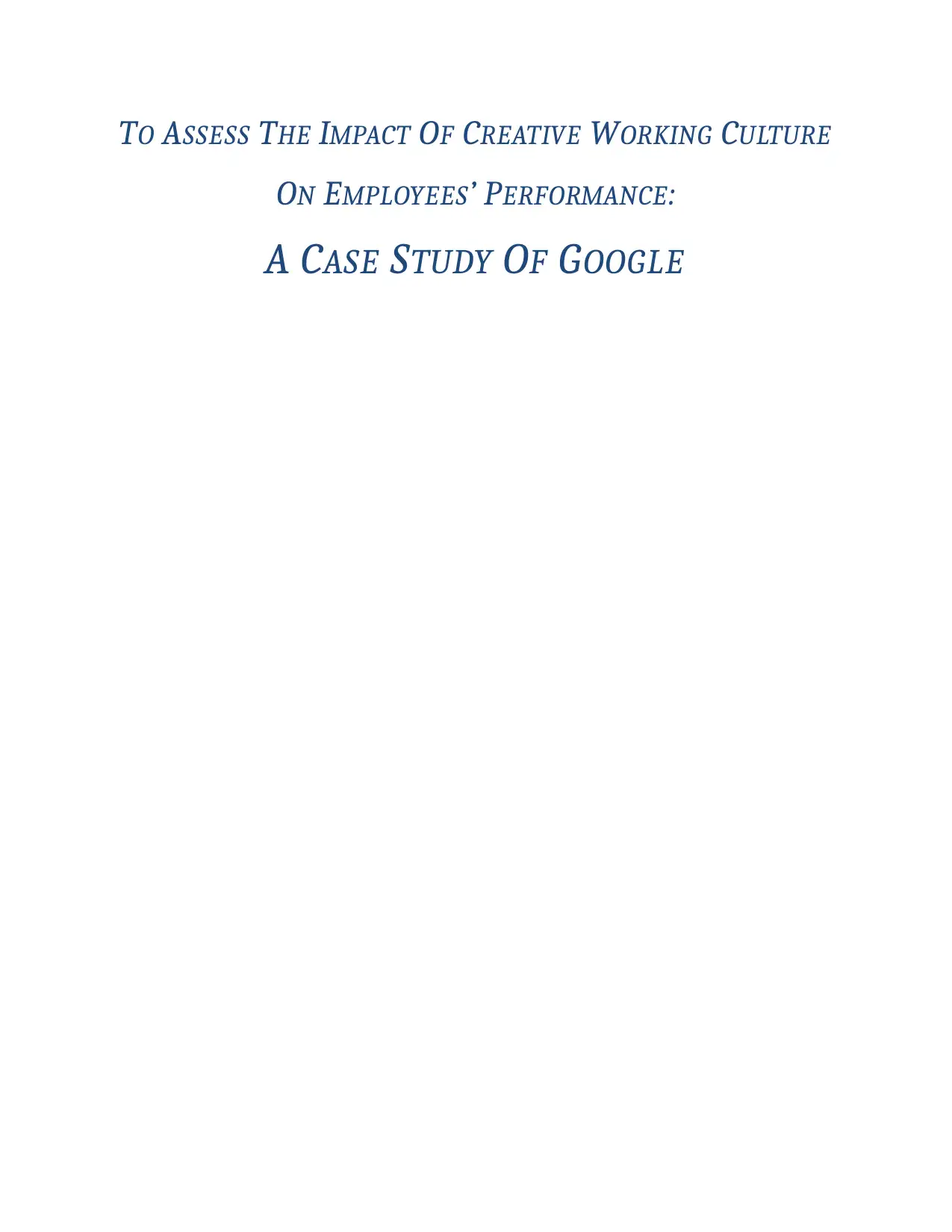
TO ASSESS THE IMPACT OF CREATIVE WORKING CULTURE
ON EMPLOYEES’ PERFORMANCE:
A CASE STUDY OF GOOGLE
ON EMPLOYEES’ PERFORMANCE:
A CASE STUDY OF GOOGLE
Paraphrase This Document
Need a fresh take? Get an instant paraphrase of this document with our AI Paraphraser
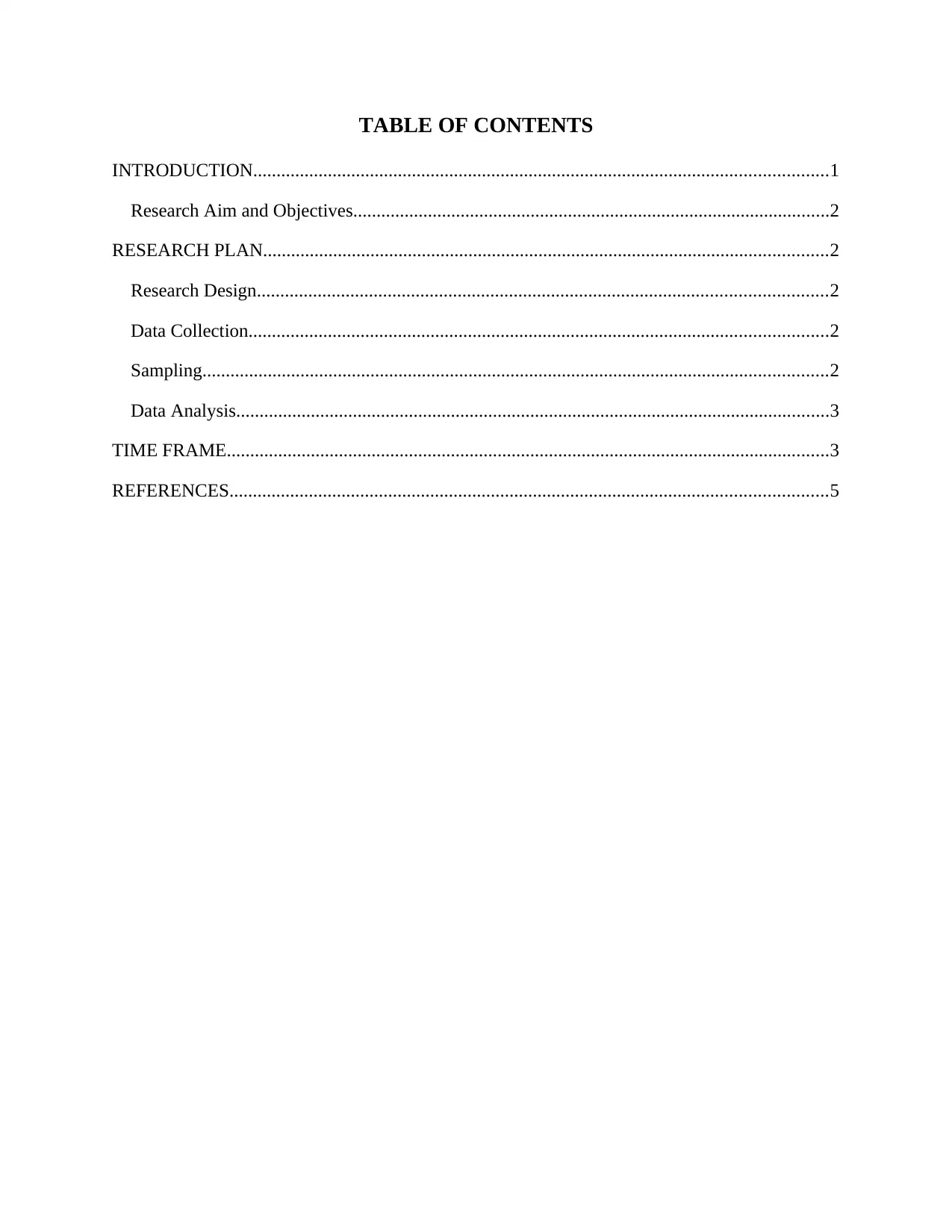
TABLE OF CONTENTS
INTRODUCTION...........................................................................................................................1
Research Aim and Objectives......................................................................................................2
RESEARCH PLAN.........................................................................................................................2
Research Design..........................................................................................................................2
Data Collection............................................................................................................................2
Sampling......................................................................................................................................2
Data Analysis...............................................................................................................................3
TIME FRAME.................................................................................................................................3
REFERENCES................................................................................................................................5
INTRODUCTION...........................................................................................................................1
Research Aim and Objectives......................................................................................................2
RESEARCH PLAN.........................................................................................................................2
Research Design..........................................................................................................................2
Data Collection............................................................................................................................2
Sampling......................................................................................................................................2
Data Analysis...............................................................................................................................3
TIME FRAME.................................................................................................................................3
REFERENCES................................................................................................................................5
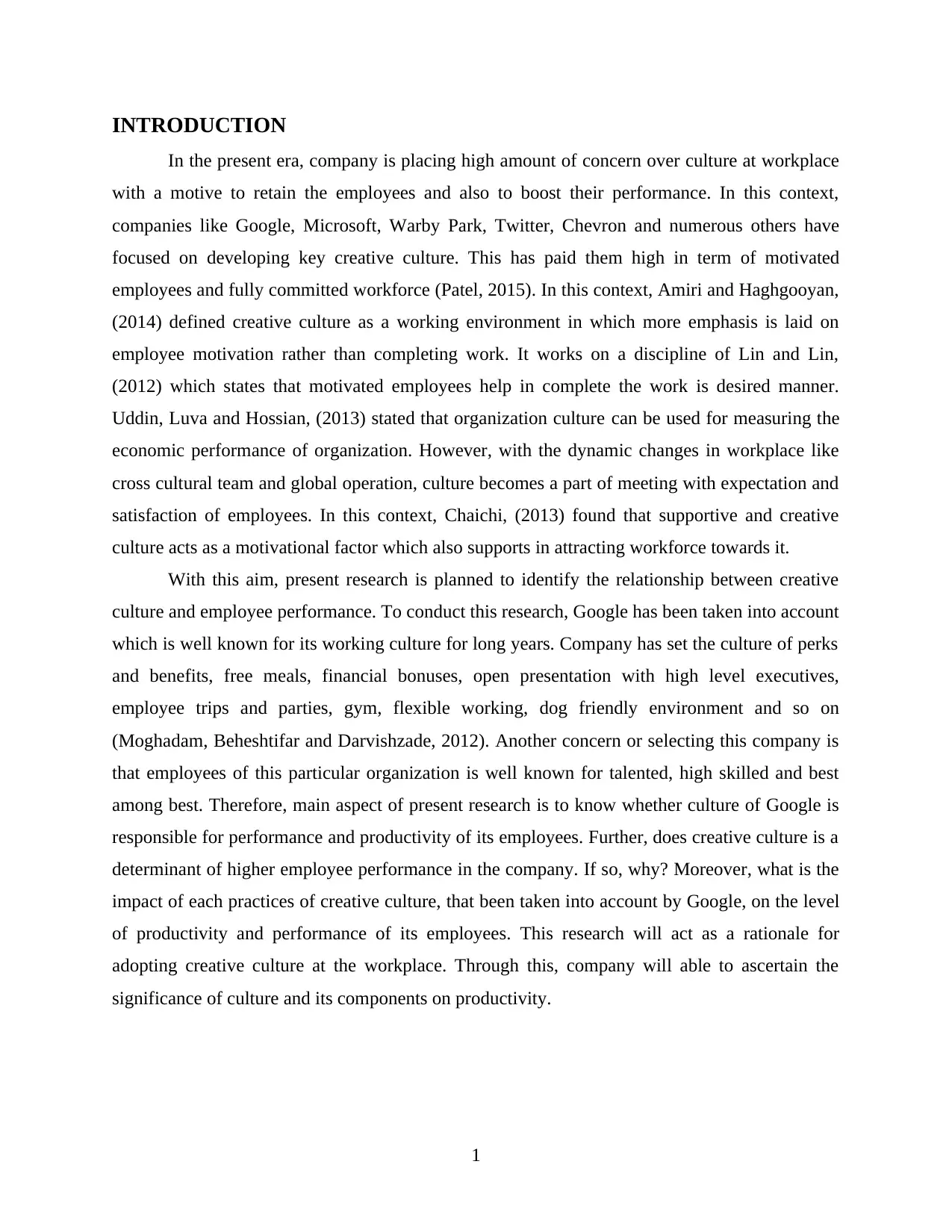
INTRODUCTION
In the present era, company is placing high amount of concern over culture at workplace
with a motive to retain the employees and also to boost their performance. In this context,
companies like Google, Microsoft, Warby Park, Twitter, Chevron and numerous others have
focused on developing key creative culture. This has paid them high in term of motivated
employees and fully committed workforce (Patel, 2015). In this context, Amiri and Haghgooyan,
(2014) defined creative culture as a working environment in which more emphasis is laid on
employee motivation rather than completing work. It works on a discipline of Lin and Lin,
(2012) which states that motivated employees help in complete the work is desired manner.
Uddin, Luva and Hossian, (2013) stated that organization culture can be used for measuring the
economic performance of organization. However, with the dynamic changes in workplace like
cross cultural team and global operation, culture becomes a part of meeting with expectation and
satisfaction of employees. In this context, Chaichi, (2013) found that supportive and creative
culture acts as a motivational factor which also supports in attracting workforce towards it.
With this aim, present research is planned to identify the relationship between creative
culture and employee performance. To conduct this research, Google has been taken into account
which is well known for its working culture for long years. Company has set the culture of perks
and benefits, free meals, financial bonuses, open presentation with high level executives,
employee trips and parties, gym, flexible working, dog friendly environment and so on
(Moghadam, Beheshtifar and Darvishzade, 2012). Another concern or selecting this company is
that employees of this particular organization is well known for talented, high skilled and best
among best. Therefore, main aspect of present research is to know whether culture of Google is
responsible for performance and productivity of its employees. Further, does creative culture is a
determinant of higher employee performance in the company. If so, why? Moreover, what is the
impact of each practices of creative culture, that been taken into account by Google, on the level
of productivity and performance of its employees. This research will act as a rationale for
adopting creative culture at the workplace. Through this, company will able to ascertain the
significance of culture and its components on productivity.
1
In the present era, company is placing high amount of concern over culture at workplace
with a motive to retain the employees and also to boost their performance. In this context,
companies like Google, Microsoft, Warby Park, Twitter, Chevron and numerous others have
focused on developing key creative culture. This has paid them high in term of motivated
employees and fully committed workforce (Patel, 2015). In this context, Amiri and Haghgooyan,
(2014) defined creative culture as a working environment in which more emphasis is laid on
employee motivation rather than completing work. It works on a discipline of Lin and Lin,
(2012) which states that motivated employees help in complete the work is desired manner.
Uddin, Luva and Hossian, (2013) stated that organization culture can be used for measuring the
economic performance of organization. However, with the dynamic changes in workplace like
cross cultural team and global operation, culture becomes a part of meeting with expectation and
satisfaction of employees. In this context, Chaichi, (2013) found that supportive and creative
culture acts as a motivational factor which also supports in attracting workforce towards it.
With this aim, present research is planned to identify the relationship between creative
culture and employee performance. To conduct this research, Google has been taken into account
which is well known for its working culture for long years. Company has set the culture of perks
and benefits, free meals, financial bonuses, open presentation with high level executives,
employee trips and parties, gym, flexible working, dog friendly environment and so on
(Moghadam, Beheshtifar and Darvishzade, 2012). Another concern or selecting this company is
that employees of this particular organization is well known for talented, high skilled and best
among best. Therefore, main aspect of present research is to know whether culture of Google is
responsible for performance and productivity of its employees. Further, does creative culture is a
determinant of higher employee performance in the company. If so, why? Moreover, what is the
impact of each practices of creative culture, that been taken into account by Google, on the level
of productivity and performance of its employees. This research will act as a rationale for
adopting creative culture at the workplace. Through this, company will able to ascertain the
significance of culture and its components on productivity.
1
⊘ This is a preview!⊘
Do you want full access?
Subscribe today to unlock all pages.

Trusted by 1+ million students worldwide
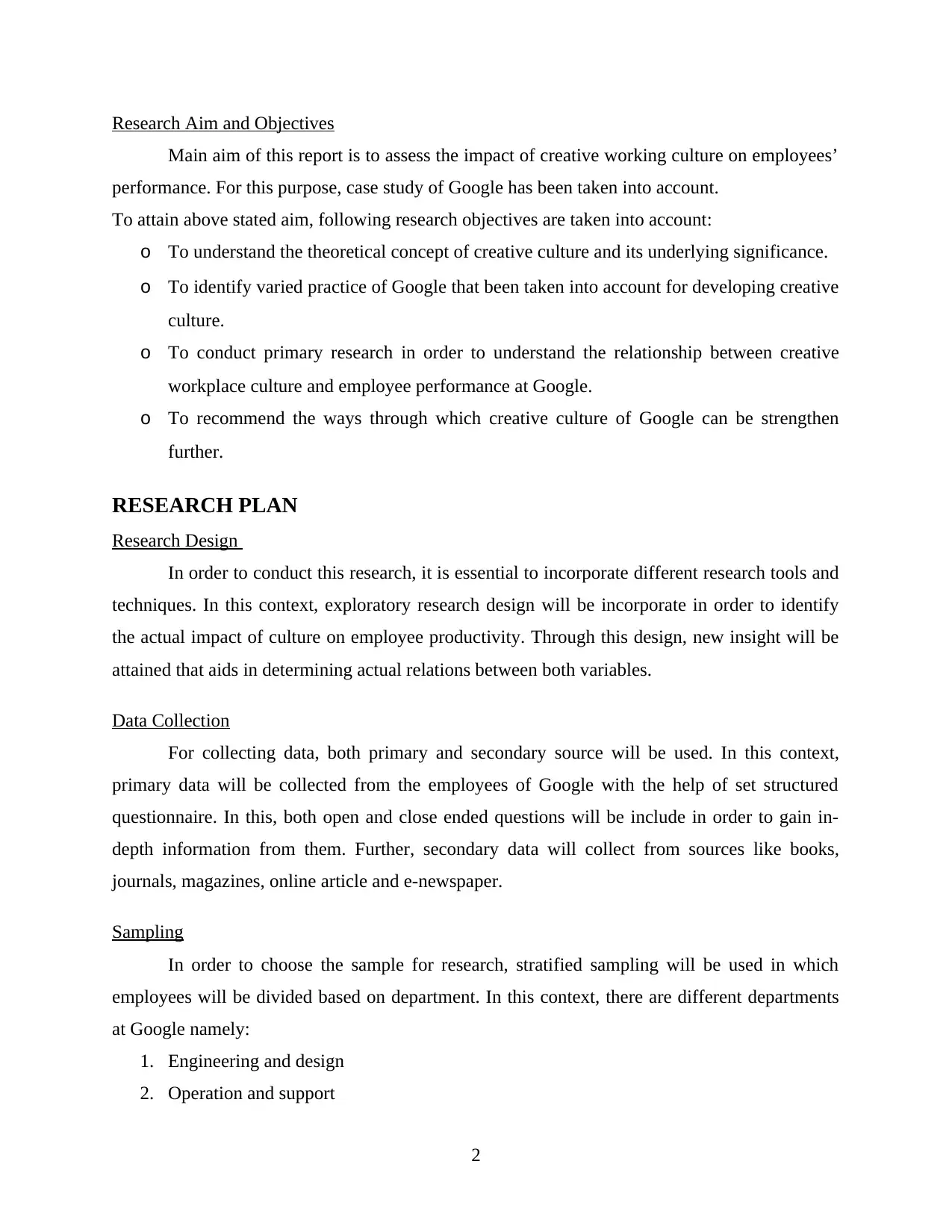
Research Aim and Objectives
Main aim of this report is to assess the impact of creative working culture on employees’
performance. For this purpose, case study of Google has been taken into account.
To attain above stated aim, following research objectives are taken into account:
o To understand the theoretical concept of creative culture and its underlying significance.
o To identify varied practice of Google that been taken into account for developing creative
culture.
o To conduct primary research in order to understand the relationship between creative
workplace culture and employee performance at Google.
o To recommend the ways through which creative culture of Google can be strengthen
further.
RESEARCH PLAN
Research Design
In order to conduct this research, it is essential to incorporate different research tools and
techniques. In this context, exploratory research design will be incorporate in order to identify
the actual impact of culture on employee productivity. Through this design, new insight will be
attained that aids in determining actual relations between both variables.
Data Collection
For collecting data, both primary and secondary source will be used. In this context,
primary data will be collected from the employees of Google with the help of set structured
questionnaire. In this, both open and close ended questions will be include in order to gain in-
depth information from them. Further, secondary data will collect from sources like books,
journals, magazines, online article and e-newspaper.
Sampling
In order to choose the sample for research, stratified sampling will be used in which
employees will be divided based on department. In this context, there are different departments
at Google namely:
1. Engineering and design
2. Operation and support
2
Main aim of this report is to assess the impact of creative working culture on employees’
performance. For this purpose, case study of Google has been taken into account.
To attain above stated aim, following research objectives are taken into account:
o To understand the theoretical concept of creative culture and its underlying significance.
o To identify varied practice of Google that been taken into account for developing creative
culture.
o To conduct primary research in order to understand the relationship between creative
workplace culture and employee performance at Google.
o To recommend the ways through which creative culture of Google can be strengthen
further.
RESEARCH PLAN
Research Design
In order to conduct this research, it is essential to incorporate different research tools and
techniques. In this context, exploratory research design will be incorporate in order to identify
the actual impact of culture on employee productivity. Through this design, new insight will be
attained that aids in determining actual relations between both variables.
Data Collection
For collecting data, both primary and secondary source will be used. In this context,
primary data will be collected from the employees of Google with the help of set structured
questionnaire. In this, both open and close ended questions will be include in order to gain in-
depth information from them. Further, secondary data will collect from sources like books,
journals, magazines, online article and e-newspaper.
Sampling
In order to choose the sample for research, stratified sampling will be used in which
employees will be divided based on department. In this context, there are different departments
at Google namely:
1. Engineering and design
2. Operation and support
2
Paraphrase This Document
Need a fresh take? Get an instant paraphrase of this document with our AI Paraphraser
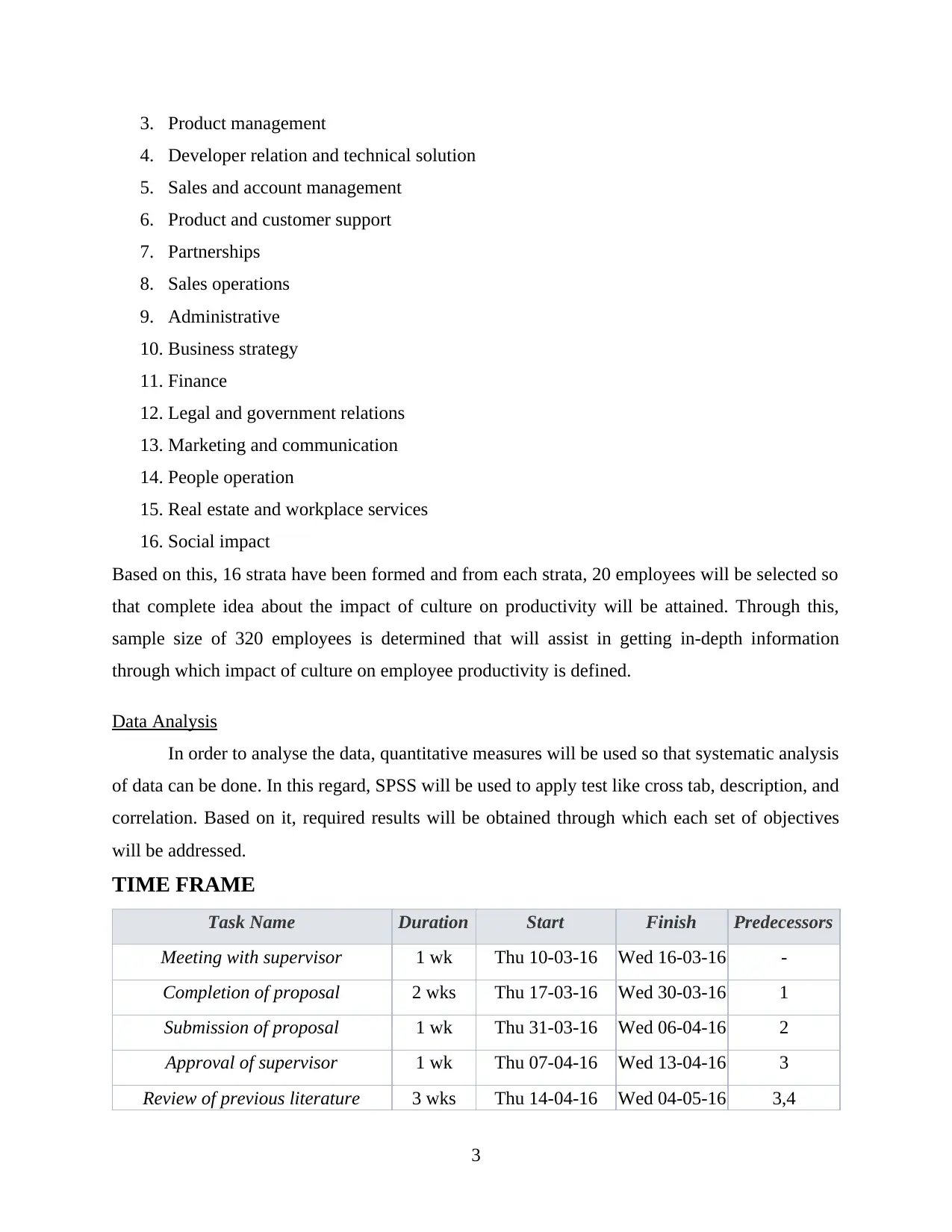
3. Product management
4. Developer relation and technical solution
5. Sales and account management
6. Product and customer support
7. Partnerships
8. Sales operations
9. Administrative
10. Business strategy
11. Finance
12. Legal and government relations
13. Marketing and communication
14. People operation
15. Real estate and workplace services
16. Social impact
Based on this, 16 strata have been formed and from each strata, 20 employees will be selected so
that complete idea about the impact of culture on productivity will be attained. Through this,
sample size of 320 employees is determined that will assist in getting in-depth information
through which impact of culture on employee productivity is defined.
Data Analysis
In order to analyse the data, quantitative measures will be used so that systematic analysis
of data can be done. In this regard, SPSS will be used to apply test like cross tab, description, and
correlation. Based on it, required results will be obtained through which each set of objectives
will be addressed.
TIME FRAME
Task Name Duration Start Finish Predecessors
Meeting with supervisor 1 wk Thu 10-03-16 Wed 16-03-16 -
Completion of proposal 2 wks Thu 17-03-16 Wed 30-03-16 1
Submission of proposal 1 wk Thu 31-03-16 Wed 06-04-16 2
Approval of supervisor 1 wk Thu 07-04-16 Wed 13-04-16 3
Review of previous literature 3 wks Thu 14-04-16 Wed 04-05-16 3,4
3
4. Developer relation and technical solution
5. Sales and account management
6. Product and customer support
7. Partnerships
8. Sales operations
9. Administrative
10. Business strategy
11. Finance
12. Legal and government relations
13. Marketing and communication
14. People operation
15. Real estate and workplace services
16. Social impact
Based on this, 16 strata have been formed and from each strata, 20 employees will be selected so
that complete idea about the impact of culture on productivity will be attained. Through this,
sample size of 320 employees is determined that will assist in getting in-depth information
through which impact of culture on employee productivity is defined.
Data Analysis
In order to analyse the data, quantitative measures will be used so that systematic analysis
of data can be done. In this regard, SPSS will be used to apply test like cross tab, description, and
correlation. Based on it, required results will be obtained through which each set of objectives
will be addressed.
TIME FRAME
Task Name Duration Start Finish Predecessors
Meeting with supervisor 1 wk Thu 10-03-16 Wed 16-03-16 -
Completion of proposal 2 wks Thu 17-03-16 Wed 30-03-16 1
Submission of proposal 1 wk Thu 31-03-16 Wed 06-04-16 2
Approval of supervisor 1 wk Thu 07-04-16 Wed 13-04-16 3
Review of previous literature 3 wks Thu 14-04-16 Wed 04-05-16 3,4
3
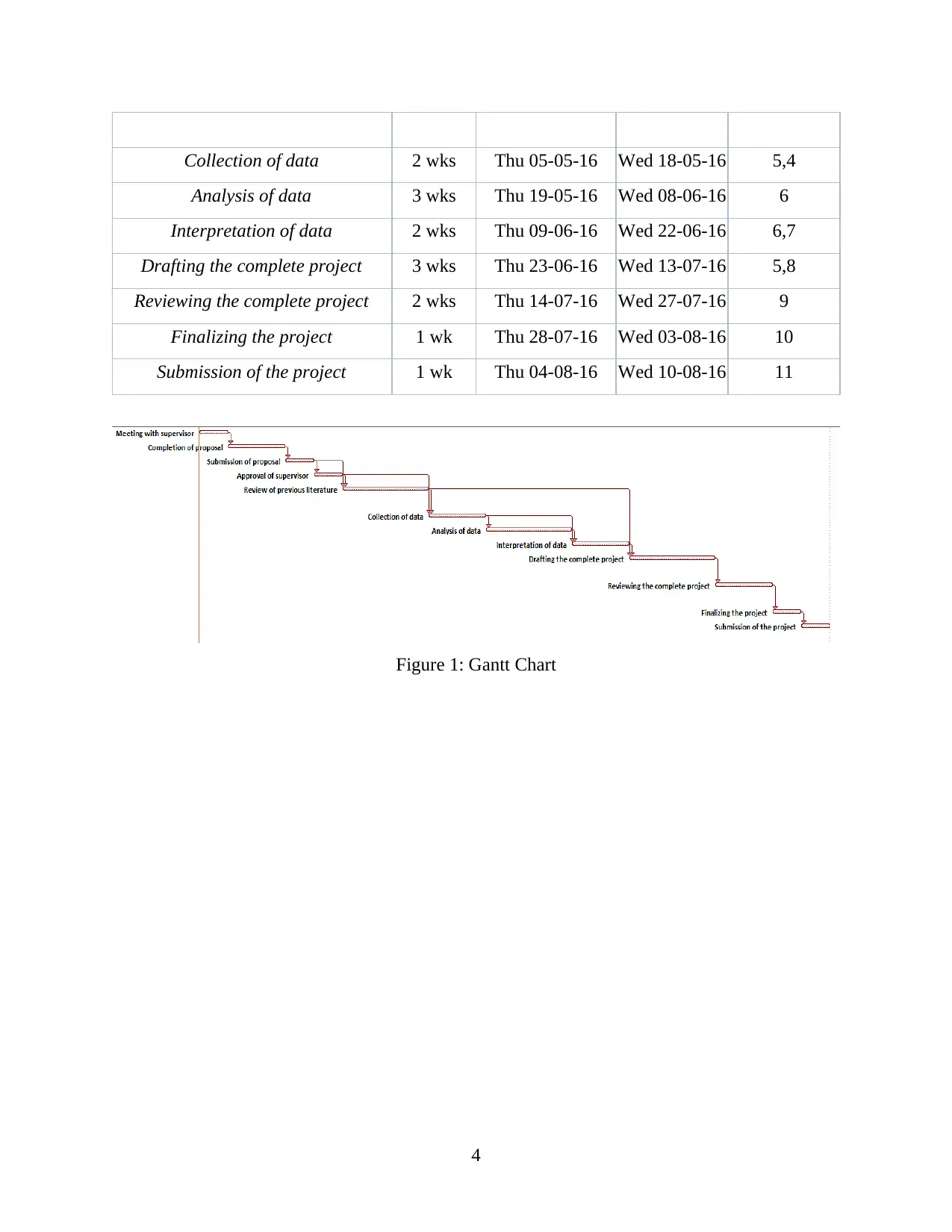
Collection of data 2 wks Thu 05-05-16 Wed 18-05-16 5,4
Analysis of data 3 wks Thu 19-05-16 Wed 08-06-16 6
Interpretation of data 2 wks Thu 09-06-16 Wed 22-06-16 6,7
Drafting the complete project 3 wks Thu 23-06-16 Wed 13-07-16 5,8
Reviewing the complete project 2 wks Thu 14-07-16 Wed 27-07-16 9
Finalizing the project 1 wk Thu 28-07-16 Wed 03-08-16 10
Submission of the project 1 wk Thu 04-08-16 Wed 10-08-16 11
Figure 1: Gantt Chart
4
Analysis of data 3 wks Thu 19-05-16 Wed 08-06-16 6
Interpretation of data 2 wks Thu 09-06-16 Wed 22-06-16 6,7
Drafting the complete project 3 wks Thu 23-06-16 Wed 13-07-16 5,8
Reviewing the complete project 2 wks Thu 14-07-16 Wed 27-07-16 9
Finalizing the project 1 wk Thu 28-07-16 Wed 03-08-16 10
Submission of the project 1 wk Thu 04-08-16 Wed 10-08-16 11
Figure 1: Gantt Chart
4
⊘ This is a preview!⊘
Do you want full access?
Subscribe today to unlock all pages.

Trusted by 1+ million students worldwide
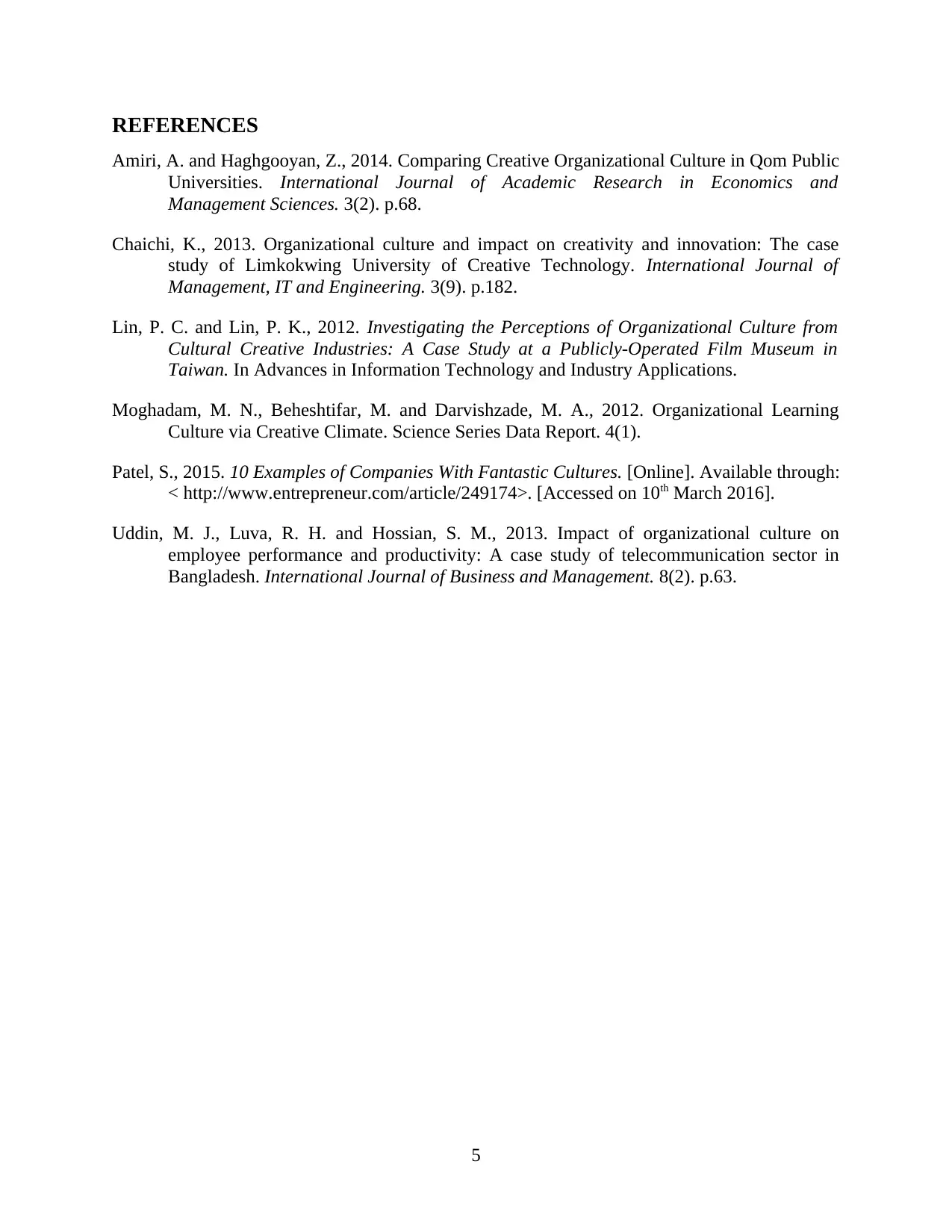
REFERENCES
Amiri, A. and Haghgooyan, Z., 2014. Comparing Creative Organizational Culture in Qom Public
Universities. International Journal of Academic Research in Economics and
Management Sciences. 3(2). p.68.
Chaichi, K., 2013. Organizational culture and impact on creativity and innovation: The case
study of Limkokwing University of Creative Technology. International Journal of
Management, IT and Engineering. 3(9). p.182.
Lin, P. C. and Lin, P. K., 2012. Investigating the Perceptions of Organizational Culture from
Cultural Creative Industries: A Case Study at a Publicly-Operated Film Museum in
Taiwan. In Advances in Information Technology and Industry Applications.
Moghadam, M. N., Beheshtifar, M. and Darvishzade, M. A., 2012. Organizational Learning
Culture via Creative Climate. Science Series Data Report. 4(1).
Patel, S., 2015. 10 Examples of Companies With Fantastic Cultures. [Online]. Available through:
< http://www.entrepreneur.com/article/249174>. [Accessed on 10th March 2016].
Uddin, M. J., Luva, R. H. and Hossian, S. M., 2013. Impact of organizational culture on
employee performance and productivity: A case study of telecommunication sector in
Bangladesh. International Journal of Business and Management. 8(2). p.63.
5
Amiri, A. and Haghgooyan, Z., 2014. Comparing Creative Organizational Culture in Qom Public
Universities. International Journal of Academic Research in Economics and
Management Sciences. 3(2). p.68.
Chaichi, K., 2013. Organizational culture and impact on creativity and innovation: The case
study of Limkokwing University of Creative Technology. International Journal of
Management, IT and Engineering. 3(9). p.182.
Lin, P. C. and Lin, P. K., 2012. Investigating the Perceptions of Organizational Culture from
Cultural Creative Industries: A Case Study at a Publicly-Operated Film Museum in
Taiwan. In Advances in Information Technology and Industry Applications.
Moghadam, M. N., Beheshtifar, M. and Darvishzade, M. A., 2012. Organizational Learning
Culture via Creative Climate. Science Series Data Report. 4(1).
Patel, S., 2015. 10 Examples of Companies With Fantastic Cultures. [Online]. Available through:
< http://www.entrepreneur.com/article/249174>. [Accessed on 10th March 2016].
Uddin, M. J., Luva, R. H. and Hossian, S. M., 2013. Impact of organizational culture on
employee performance and productivity: A case study of telecommunication sector in
Bangladesh. International Journal of Business and Management. 8(2). p.63.
5
1 out of 7
Related Documents
Your All-in-One AI-Powered Toolkit for Academic Success.
+13062052269
info@desklib.com
Available 24*7 on WhatsApp / Email
![[object Object]](/_next/static/media/star-bottom.7253800d.svg)
Unlock your academic potential
Copyright © 2020–2025 A2Z Services. All Rights Reserved. Developed and managed by ZUCOL.





